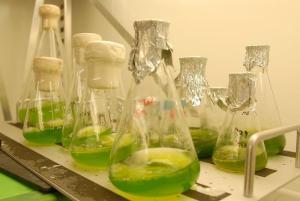|
Related Topics: |
|
|
|
Current News |
|
Chemistry A to Z |
|
About Internetchemistry |
Light-Harvesting Protein LHCSR3: Sun Protective Factor in algae |
|
Light is of vital importance. However, excessive sunbathing causes sunburn - and not only in people and animals. Intensive exposure to sunlight can be harmful for plants, too. A team of scientists from Münster and the USA have now been able to show for the first time how green algae protect themselves against such damage. The journal "Nature" carries a report on this in the issue published on 26 November 2009. Plants are dependent on sunlight for growth. With the aid of light energy they produce sugar molecules which are converted into components of their cells and act as suppliers of energy. In this process plants extract carbon dioxide from the atmosphere and release oxygen. This process - called photosynthesis - is the basis of all life on earth. "Photosynthesis provides the vegetable biomass - and thus the basis of food supply - for people and animals," says Prof. Michael Hippler from the Institute of Biochemistry and Plant Biotechnology at Münster University. |
|
However, using light energy to produce biomass is a tricky business for plants. The absorption of light through cellular pigment molecules, e.g. through chlorophyll, can lead to the production of oxygen radicals in plants and thus damage them. "In order to protect themselves from such oxidative destruction - 'sunburn', so to speak," says Prof. Hippler, "plants have developed mechanisms for converting the surplus light energy into heat energy. Although algae produce a large share of the biomass generated worldwide, very little was known up to now about this protective mechanism in algae - in contrast to flowering plants." An international team of scientists led by Prof. Hippler and Prof. Kris Niyogi from the University of California in Berkeley, USA, have now thrown light on this sun protection mechanism in the unicellular green alga Chlamydomonas reinhardtii. The sun protection factor is a certain light-harvesting protein (LHCSR3). "In general," explains Prof. Hippler, "such proteins harvest light - as their name suggests - and they make it available for photosynthesis. In this particular case, however, the protein permits the conversion of light energy to heat energy and in the process it renders the surplus light energy harmless." In comparison to traditional light-harvesting proteins, LHCSR3 has very old origins, probably stemming directly from the 'forebear' of all light-harvesting proteins. If there is any obstacle to the production of this protein, the algae are no longer able to dissipate harmful excess energy. They then get 'sunburn', which can in fact result in the alga cells dying. "Interestingly, flowering plants have lost these protein molecules during their evolution and have developed another sun protection mechanism in which light is also converted into heat energy," says Prof. Hippler. "The discovery of the 'sun protection factor' in algae makes it possible for us to have deep insights into the regulation of aquatic photosynthesis, which is responsible for 50 percent of the primary production of biomass worldwide." Moreover, he says, the insights could be used to optimize the culture of micro-algae in bio-reactors. In this way the biotechnological production of biomass from algae could be improved, e.g. for the production of bio-fuels. |
|
|
|

